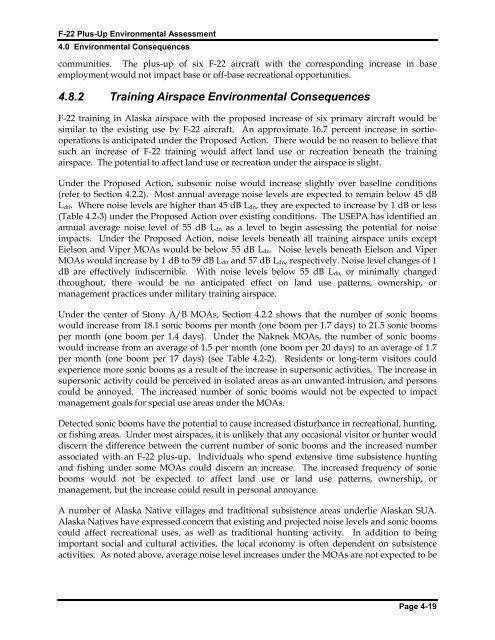F-22 Plus-Up Environmental Assessment - Joint Base Elmendorf ...
F-22 Plus-Up Environmental Assessment - Joint Base Elmendorf ...
F-22 Plus-Up Environmental Assessment - Joint Base Elmendorf ...
Create successful ePaper yourself
Turn your PDF publications into a flip-book with our unique Google optimized e-Paper software.
F-<strong>22</strong> <strong>Plus</strong>-<strong>Up</strong> <strong>Environmental</strong> <strong>Assessment</strong><br />
4.0 <strong>Environmental</strong> Consequences<br />
communities. The plus-up of six F-<strong>22</strong> aircraft with the corresponding increase in base<br />
employment would not impact base or off-base recreational opportunities.<br />
4.8.2 Training Airspace <strong>Environmental</strong> Consequences<br />
F-<strong>22</strong> training in Alaska airspace with the proposed increase of six primary aircraft would be<br />
similar to the existing use by F-<strong>22</strong> aircraft. An approximate 16.7 percent increase in sortieoperations<br />
is anticipated under the Proposed Action. There would be no reason to believe that<br />
such an increase of F-<strong>22</strong> training would affect land use or recreation beneath the training<br />
airspace. The potential to affect land use or recreation under the airspace is slight.<br />
Under the Proposed Action, subsonic noise would increase slightly over baseline conditions<br />
(refer to Section 4.2.2). Most annual average noise levels are expected to remain below 45 dB<br />
L dn. Where noise levels are higher than 45 dB L dn, they are expected to increase by 1 dB or less<br />
(Table 4.2-3) under the Proposed Action over existing conditions. The USEPA has identified an<br />
annual average noise level of 55 dB L dn as a level to begin assessing the potential for noise<br />
impacts. Under the Proposed Action, noise levels beneath all training airspace units except<br />
Eielson and Viper MOAs would be below 55 dB L dn. Noise levels beneath Eielson and Viper<br />
MOAs would increase by 1 dB to 59 dB L dn and 57 dB L dn, respectively. Noise level changes of 1<br />
dB are effectively indiscernible. With noise levels below 55 dB L dn, or minimally changed<br />
throughout, there would be no anticipated effect on land use patterns, ownership, or<br />
management practices under military training airspace.<br />
Under the center of Stony A/B MOAs, Section 4.2.2 shows that the number of sonic booms<br />
would increase from 18.1 sonic booms per month (one boom per 1.7 days) to 21.5 sonic booms<br />
per month (one boom per 1.4 days). Under the Naknek MOAs, the number of sonic booms<br />
would increase from an average of 1.5 per month (one boom per 20 days) to an average of 1.7<br />
per month (one boom per 17 days) (see Table 4.2-2). Residents or long-term visitors could<br />
experience more sonic booms as a result of the increase in supersonic activities. The increase in<br />
supersonic activity could be perceived in isolated areas as an unwanted intrusion, and persons<br />
could be annoyed. The increased number of sonic booms would not be expected to impact<br />
management goals for special use areas under the MOAs.<br />
Detected sonic booms have the potential to cause increased disturbance in recreational, hunting,<br />
or fishing areas. Under most airspaces, it is unlikely that any occasional visitor or hunter would<br />
discern the difference between the current number of sonic booms and the increased number<br />
associated with an F-<strong>22</strong> plus-up. Individuals who spend extensive time subsistence hunting<br />
and fishing under some MOAs could discern an increase. The increased frequency of sonic<br />
booms would not be expected to affect land use or land use patterns, ownership, or<br />
management, but the increase could result in personal annoyance.<br />
A number of Alaska Native villages and traditional subsistence areas underlie Alaskan SUA.<br />
Alaska Natives have expressed concern that existing and projected noise levels and sonic booms<br />
could affect recreational uses, as well as traditional hunting activity. In addition to being<br />
important social and cultural activities, the local economy is often dependent on subsistence<br />
activities. As noted above, average noise level increases under the MOAs are not expected to be<br />
Page 4-19
















